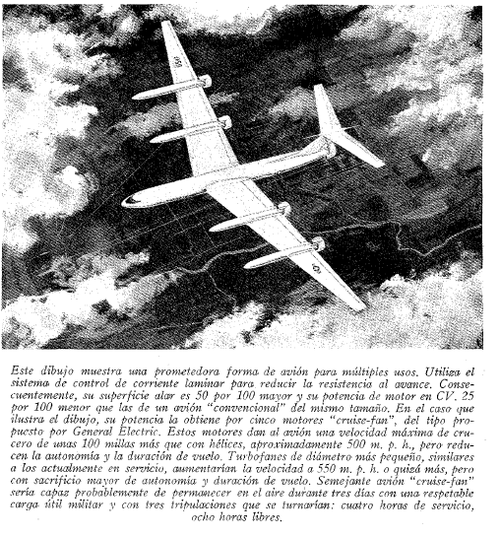- Joined
- 26 May 2006
- Messages
- 32,694
- Reaction score
- 11,928
From, Revista de Aeronautica y Astronautica 1964,
This drawing shows a promising airplane shape for multiple uses. It
uses the laminar current control system to reduce drag. Consequently,
its wing area is 50% larger and its engine power in 25 hp per 100 smaller
than those of a “conventional” airplane of the same size. In the event that
The drawing polishes, its power is obtained by five "cruise-fan" engines, of
the type proposed by General Electric. These engines give the aircraft a
maximum cruising speed of about 100 meshes more than with propellers,
approximately 500 m. p. h., but reduce autonomy and flight duration.
Smaller diameter turbofans, similar to those currently in service, they would
increase the speed to 500 m. p. h. or maybe more, but with greater sacrifice
of autonomy and flight duration. Such a "cruise-fan" plane would probably
be able to stay in the air for three days with a respectable military payload
and with three crews taking turns: four hours of service, eight hours off.
Who can ID the aircraft,and I suspect if we discussed it before,it had a familiar
shape,I could be wrong,but I use the search and find nothing ?!.
This drawing shows a promising airplane shape for multiple uses. It
uses the laminar current control system to reduce drag. Consequently,
its wing area is 50% larger and its engine power in 25 hp per 100 smaller
than those of a “conventional” airplane of the same size. In the event that
The drawing polishes, its power is obtained by five "cruise-fan" engines, of
the type proposed by General Electric. These engines give the aircraft a
maximum cruising speed of about 100 meshes more than with propellers,
approximately 500 m. p. h., but reduce autonomy and flight duration.
Smaller diameter turbofans, similar to those currently in service, they would
increase the speed to 500 m. p. h. or maybe more, but with greater sacrifice
of autonomy and flight duration. Such a "cruise-fan" plane would probably
be able to stay in the air for three days with a respectable military payload
and with three crews taking turns: four hours of service, eight hours off.
Who can ID the aircraft,and I suspect if we discussed it before,it had a familiar
shape,I could be wrong,but I use the search and find nothing ?!.
Attachments
Last edited:

